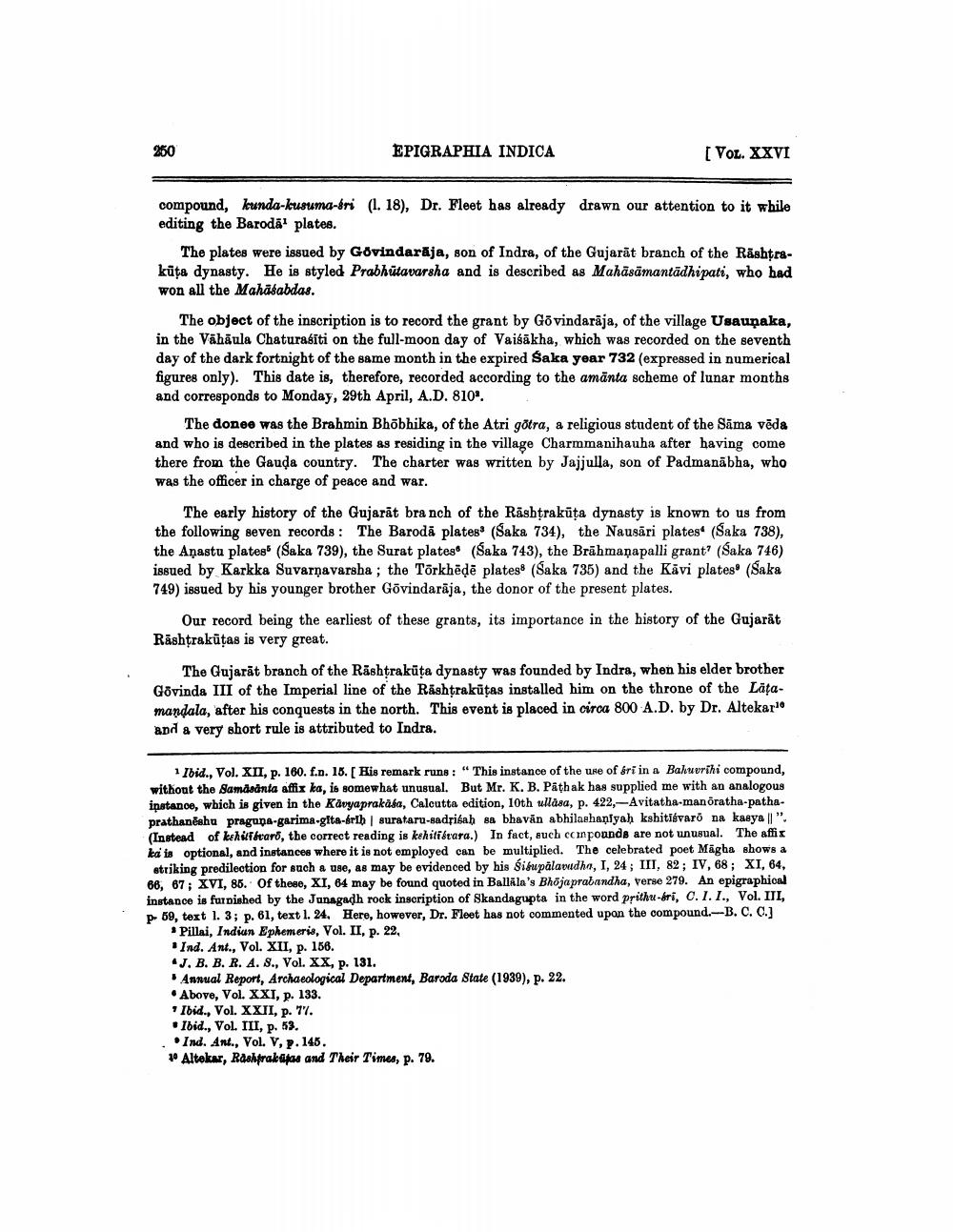________________
250
EPIGRAPHIA INDICA
(VOL. XXVI
compound, kunda-kusuma-bri (1. 18), Dr. Fleet has already drawn our attention to it while editing the Barodāt plates.
The plates were issued by Govindarāja, son of Indra, of the Gujarāt branch of the Rashtrakūta dynasty. He is styled Prabhutavarsha and is described as Mahāsāmantādhipati, who had won all the Mahāšabdas.
The object of the inscription is to record the grant by Govindarāja, of the village Usauņaka, in the Vāhāula Chaturasīti on the full-moon day of Vaišākha, which was recorded on the seventh day of the dark fortnight of the same month in the expired Saka year 732 (expressed in numerical figures only). This date is, therefore, recorded according to the amānta scheme of lunar months and corresponds to Monday, 29th April, A.D. 810".
The donee was the Brahmin Bhõbhika, of the Atri götra, a religious student of the Sāma vēda and who is described in the plates as residing in the village Charmmanihauha after having come there from the Gauda country. The charter was written by Jajjulla, son of Padmanābha, who was the officer in charge of peace and war.
The early history of the Gujarāt bra nch of the Rashtrakūta dynasty is known to us from the following seven records : The Barodā platego (Saka 734), the Nausāri plates (Saka 738), the Anastu plates (Saka 739), the Surat plates (Saka 743), the Brāhmaṇapalli grant? (saka 746) issued by Karkka Suvarnavarsha; the Tõrkhēdē plates (Saka 735) and the Kävi plates (Saka 749) issued by his younger brother Govindarāja, the donor of the present plates.
Our record being the earliest of these grants, its importance in the history of the Gujarat Rāshtrakūtas is very great.
The Gujarat branch of the Rashtrakūta dynasty was founded by Indra, when his elder brother Govinda III of the Imperial line of the Rashtrakūtas installed him on the throne of the Läțamandala, after his conquests in the north. This event is placed in oiroa 800 A.D. by Dr. Altekar and a very short rule is attributed to Indra.
1 Ibid., Vol. XII, p. 160. f.n. 18. His remark runs: "This instance of the use of Sri in a Bahuurihi compound, without the Samdsänta affix ka, is somewhat unusual. But Mr. K. B. Pathak has supplied me with an analogous inatanoe, which is given in the Kavyaprakada, Calcutta edition, 10th ullasa, p. 422,-Avitatha-man öratha-pathaprathanehu praguna-garima-gita-erth | surataru-sadrifah sa bhavan abhilashaniyah kshitiévaro na kaya || ". (Instead of kehiTharo, the correct reading is kehitibuara.) In fact, such ccnpounds are not unusual. The affix la is optional, and instances where it is not employed can be multiplied. The celebrated poet Magha shows a
striking predilection for such a use, as may be evidenced by his sisupälavudha, I, 24; III, 82; IV, 68; XI, 64, 66. 67. XVI, 86. Of these, XI, 64 may be found quoted in Ballala's Bhojaprabandha, verse 279. An epigraphical instance is furnished by the Junagadh rook inscription of Skandagupta in the word prithu-dri, O.I.I., Vol. III, p69, text 1. 3; p. 61, text I. 24. Here, however, Dr. Fleet has not commented upon the compound.-B.C.C.]
• Pillai, Indian Ephemeris, Vol. II, p. 22, * Ind. Ant., Vol. XII, p. 156. *J, B. B. R. A. 8., Vol. XX, p. 131.
Annual Report, Archaeological Department, Baroda State (1939), p. 22. • Above, Vol. XXI, p. 133.
Ibid., Vol. XXII, p. 77. • Ibid., VOL. III, p. 53.
Ind. Ant., Vol. V, p. 145. 10 Altekar, Rashpraküpas and Their Times, p. 79.




